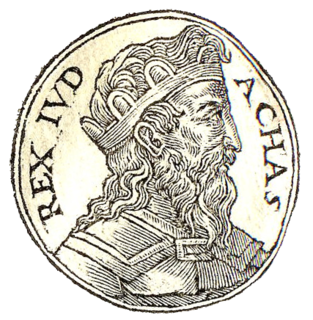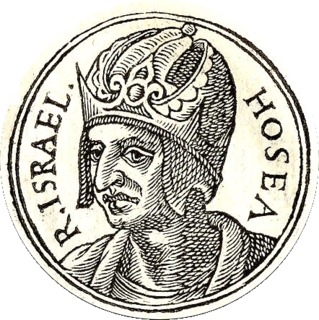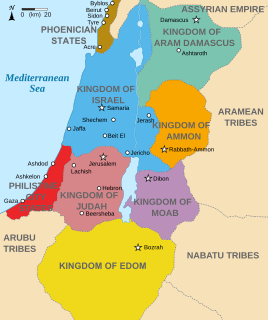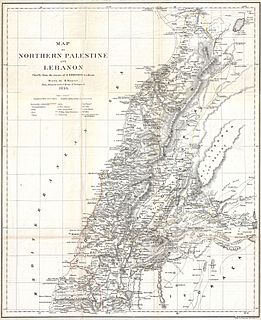The 8th century BCE started the first day of 800 BC and ended the last day of 701 BC. The 8th century BC is a period of great change for several historically significant civilizations. In Egypt, the 23rd and 24th dynasties lead to rule from Nubia in the 25th Dynasty. The Neo-Assyrian Empire reaches the peak of its power, conquering the Kingdom of Israel as well as nearby countries.

Ahaz an abbreviation of Jehoahaz II, "Yahweh has held" was the twelfth king of Judah, and the son and successor of Jotham. Ahaz was 20 when he became king of Judah and reigned for 16 years.
Tarshish occurs in the Hebrew Bible with several uncertain meanings, most frequently as a place far across the sea from Phoenicia and the Land of Israel. Tarshish was said to have exported vast quantities of important metals to Phoenicia and Israel. The same place-name occurs in the Akkadian inscriptions of Esarhaddon and also on the Phoenician inscription of the Nora Stone in Sardinia; its precise location was never commonly known, and was eventually lost in antiquity. Legends grew up around it over time so that its identity has been the subject of scholarly research and commentary for more than two thousand years.
Thapsus, also known as Tampsus and as Thapsus Minor to distinguish it from Thapsus in Sicily, was a Carthaginian and Roman port near present-day Bekalta, Tunisia.

Hoshea was the nineteenth and last king of the Israelite Kingdom of Israel and son of Elah. William F. Albright dated his reign to 732–721 BCE, while E. R. Thiele offered the dates 732–723 BCE.

Jotham or Yotam was the eleventh king of Judah, and son of King Uzziah and Jerusha, daughter of Zadok. Jotham was 25 years old when he began his reign, and he reigned for 16 years. Edwin R. Thiele concluded that his reign commenced as a coregency with his father, which lasted for 11 years. Because his father Uzziah was afflicted with tzaraath after he went into the Temple to burn incense, Jotham became governor of the palace and the land at that time, i.e. coregent, while his father lived in a separate house as a leper.
The King of Tyre was the ruler of Tyre, the ancient Phoenician city in what is now Lebanon. The traditional list of 12 kings, with reigns dated to 990–785 BC, is derived from the lost history of Menander of Ephesus as quoted by Josephus in Against Apion I. 116–127. Josephus asserts that Menander had drawn his list from the chronicles of Tyre itself. Menander-Josephus also contains a list of 9 kings and judges, with reigns dated to 591–532 BC in Against Apion I. 154–160.

Baal I was a king of Tyre. His name is the same as that of the Phoenician deity, Baal. He was tributary to the Assyrians, who had conquered the rest of Phoenicia.

The Kingdom of Aram-Damascus was an Aramean polity that existed from the late-12th century BCE until 732 BCE, and was centred around the city of Damascus in the Southern Levant. Alongside various tribal lands, it was bounded in its later years by the polities of Assyria to the north, Ammon to the south, and Israel to the west.

During the Middle Assyrian Empire and the Neo-Assyrian Empire, Phoenicia, what is today known as Lebanon and coastal Syria, came under Assyrian rule on several occasions.

Tigzirt, the classical Iomnium, is a small town on the coast of northeast Algeria in Tizi Ouzou Province. It has a sleepy demeanor and attracts many tourists especially in summer from all over the country.
King Rezin of Aram or Rasin of Syria in DRB ruled from Damascus during the 8th century BC. During his reign, he was a tributary of King Tiglath-Pileser III of Assyria.
Edward Lipiński, or Edouard Lipiński, is a Polish-Belgian Biblical scholar and Orientalist.
Ithobaal II was an eighth-century BC Phoenician king of Tyre. Nothing is known of his reign except that he paid tribute to the Assyrian king Tiglath-pileser III in 738. He was succeeded that year or the next by Hiram II, who continued the tribute to the Assyrians.
Rusippisir was a Phoenician, Carthaginian, and Roman town on Algeria's Mediterranean coast at the site of present-day Taksebt.

2 Kings 16 is the sixteenth chapter of the second part of the Books of Kings in the Hebrew Bible or the Second Book of Kings in the Old Testament of the Christian Bible. The book is a compilation of various annals recording the acts of the kings of Israel and Judah by a Deuteronomic compiler in the seventh century BCE, with a supplement added in the sixth century BCE. This chapter records the events during the reign of Ahaz, the king of Judah.

Iomnium was a Phoenician, Carthaginian, and Roman port on Algeria's Mediterranean coast at the site of present-day Tigzirt.
Rusazus was a Phoenician, Carthaginian, and Roman town located near Cape Corbelin, Algeria. Its ruins are near the town of Azeffoun.
Rusubbicari was a Phoenician and Carthaginian colony and Roman town. It has been tentatively identified with ruins at Zemmouri El Bahri, Algeria. The Roman town was in the province of Mauretania Caesariensis.
Bit-Amukani was a tribe, proto-state founded by Chaldeans in southern Mesopotamia which stretched from southeast of Nippur to the area of Uruk. It is considered as one of the most powerful Chaldean tribes, next to Bīt-Iakin and Bīt-Dakkūri.